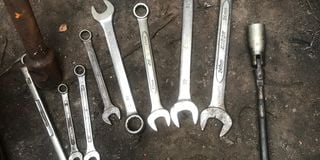Prime
Everything you need to know about spanners

The specific type of spanner wrench you need for your project depends on where the nuts and bolts are located. PHOTO/Daphine Nakabiri
What you need to know:
The precise function and application of a particular spanner set will depend on the job at hand
A spanner, also known as a wrench, is an essential piece of equipment for any job that requires fastening or loosening nuts, bolts and other fasteners. They are usually found in a car’s toolkit and are necessary in case of emergencies or maintenance needs while on the road.
Spanners are typically made from durable materials such as chrome vanadium steel or alloy steel. However, some have additional coatings or treatments for increased corrosion resistance and durability.
“Having a variety of spanners in your toolkit allows you as a motorist to tackle a wide range of maintenance and repair tasks efficiently and effectively at any time,” David Wakabi, a mechanic, says.
According to www.ronixtools.com, there are different types of spanners and these come in different sizes. As different types of spanners will differ in price, they also have different modes of application/roles they play during maintenance.
Ratchet spanners
These feature a mechanism that allows them to turn in one direction while remaining stationary, something that makes them ideal for use in tight spaces, where a full rotation is not possible.
Ratchet spanners usually have handles that come in different lengths and even include a variety of socket sizes such as four millimetres (mm) to 32mm. This feature enables faster and more efficient loosening or tightening of fasteners.
Ring/box-end
These wrenches have a closed loop ring/box-shaped opening at each end, which fits over the entire nut or bolt head. They provide a more secure grip and are less likely to round off the corners of fasteners compared to open-end wrenches.
While there are those that are single/double ended, they come in sets with sizes ranging from six millimetres to 24mm for metric wrenches and from a quarter to one inch or larger for imperial inches. They are, thus, suitable for tasks where high torque is required or where access is limited.
Socket
Socket wrenches consist of a handle and detachable cylindrical socket heads designed to fit over nuts or bolts. They allow for quick and easy changing of socket sizes, making them suitable for a wide range of fasteners such as installing or removing engine bolts. Socket spanners come in a wide range of sizes from four millimetres to 32mm and their imperial sets can range from 3/16 inch to one to quarter inch or larger.
Plug spanners
They are also known as spark plug wrenches and they feature a cylindrical shape with a or square-shaped opening on one end to fit over the hexagonal nut of a spark plug. Some of them have a rubber insert or magnet inside the socket to securely hold the spark plug in place during removal or installation.
Common sizes include 16mm, 18mm, and 21mm, which correspond to the hexagonal nut size of the spark plug. Plug spanners are, therefore, specifically designed for use in internal combustion engines to remove and install spark plugs.
Open-ended
This type of wrench has U-shaped jaws with a wrench head at each end that grip two opposite faces of the bolt or nut. Usually, they come in sets with sizes ranging from six millimetres to 32mm or larger and are used for fasteners in open spaces where there is no obstruction above or below the fastener.
However, due to their design, they are limited to grip and torque, which increases the risk of slipping or rounding off the edges of the nut or bolt.
Combination spanners
Combination wrenches feature an open-end on one side and a ring/box-end (closed) on the other side. They typically include sizes from six millimetres to 24mm for metrics and from a quarter inch to one inch or larger for imperial inches.
From their nature, they provide versatility with an open-end side for quick engagement and a ring/ box-end side for a more secure grip on rounded fasteners. Although they are suitable for various automotive tasks where both speed and torque are required, they may not fit fasteners located in extremely tight spaces or at awkward angles. In this case, specialised wrenches are required.
Adjustable spanners
These are also known as screw wrenches. These have a movable jaw that can be adjusted to fit different sizes of nuts and bolts. Although they are versatile, they may not provide as secure a grip as fixed-size spanners. They are, thus, commonly available in lengths ranging from six inches to 12 inches.
What to consider
Besides factors such as length, material, weight, head thickness and width, Wakabi says when choosing a spanner, a motorist should ensure the spanners chosen are compatible with the types of fasteners commonly found in their vehicles.
They should also be able to determine the types of maintenance and repairs they are likely to encounter.
“This will help you select the right type and size of spanners needed for common tasks such as changing tyres, adjusting brakes, or tightening bolts. However, he cautions, “Opt for spanners made from durable materials such as alloy steel since high-quality spanners may cost more upfront, but they will last longer and perform better in the long run.”
CARE.
David Wakabi, a mechanic, tips car owners on how to properly maintain spanners as this can lead to longevity, performance and reliability. Just like cleaning utensils, after using spanners, wiping dirt, grease and debris off even in the jaws is key. In order to prevent corrosion, one must use a rust-preventative spray, coatings or lubricating oil and then properly store their tools in a dry, climate-controlled environment so as to minimise exposure to moisture and humidity.




